
views
- Buy a cage that swings open and can be latched securely. Steer clear of guillotine-style cages, which can make the bird feel trapped.
- Feed your parrot a diverse and healthy diet of food pellets, nuts, seeds, fruits, and veggies. Avoid foods that are toxic to parrots, like avocados.
- Clean your parrot's cage daily, and give it a deep cleaning each week.
Basic Quaker Parrot Care

Buy the right cage. Quakers are a smaller breed of parrot, but because of their active nature, they do best with a roomy cage. An 18” x 18” x 18” cage should probably be the minimum size for your bird, but also consider safety and security features. Quaker parrots are known for being escape artists, so make sure the bars on the cage are not too far apart, nor at the same time narrow enough that a curious quaker can get its head stuck between them. ⅝-inch spacing between bars is a good reference point. Likewise, to counteract their curiosity and escapability, choose a gate that swings open (not a guillotine-style gate that a quaker may be able to lift up only to have it become a trap). Quakers have been known to figure out how to unlatch a gate, so consider a lock as well.
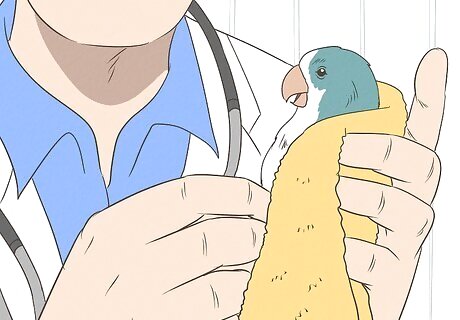
Find a good vet. Take your quaker for annual checks (and more as warranted) by a veterinarian, preferably one with a bird specialization. beak, claw, and feather health should be areas of particular focus for you and your vet, as problems in these areas are often indicators of larger issues. Quakers may be more susceptible to fatty liver disease, so don't let your bird become overweight. Limiting seeds and other high-fat foods may be necessary. Talk to your vet if you are concerned. Feather plucking is another disorder that can be common among Quakers and can have physical or behavioral causes. A good avian vet can help you with this issue as well.
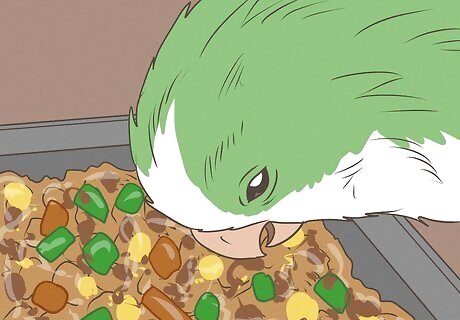
Provide a diverse diet. A repetitive daily diet of bird food pellets not only lacks the diversity to provide proper nutrition, but it may also cause boredom (and thus a lack of eating) in birds like Quakers. Make the pellets part of the diet but also mix in a variety of fruits and vegetables, and occasional seeds and nuts. Avoid feeding birds avocados, however, as this can be toxic to them; also skip chocolate, caffeine, and alcohol.
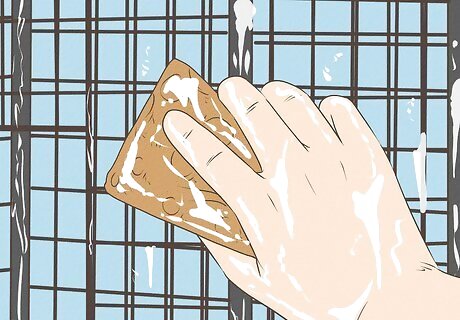
Clean up after your parrot frequently. Birds are messy—there is no way around it. In addition to droppings, Quakers will strew food scraps, destroyed toys, and bits of anything else they can get their beaks on throughout the cage and on your floor. Give the cage a quick cleanup daily, removing large bits of junk and replacing the newspaper liner (you may want to subscribe to a daily paper if you’re going to be a bird owner). Each week, give the cage a more thorough cleaning, scrubbing down the bars, and such. You may want to place the cage over an easier-to-clean floor surface, such as tile or hardwood rather than carpet.
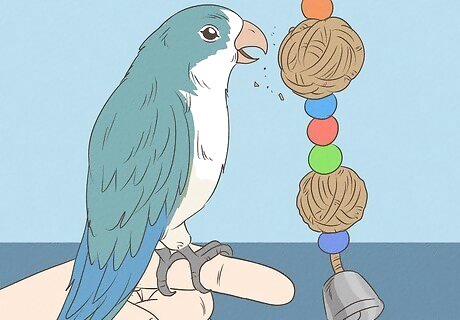
Play with your bird. Quakers need attention and generally love to play, so find time each day to spend engaging your bird’s mind and body. Teach your parrot to “step up” (hop up on your finger when you tap it on the bird’s breast) early on — this is a gateway to other commands, tricks, and games. Provide your quaker with toys and mix them up frequently to keep your parrot engaged. Quakers regularly destroy toys, so you may want to mix in homemade toys, games, and challenges. For instance, something as simple as balling up a treat in a wad of paper can provide your bird with some mental stimulation (at least the first time). Talking is no guarantee with any parrot, but Quakers usually like to talk and take to it easily. Repeating phrases during playtime is an easy way to teach new words, or move up to focused lessons of 10-15 minutes apiece. Keep in mind what Quakers hear from you (or the TV, etc.), however, as they are usually skilled and eager mimics. See also How to Play with a Large Parrot for more play ideas.
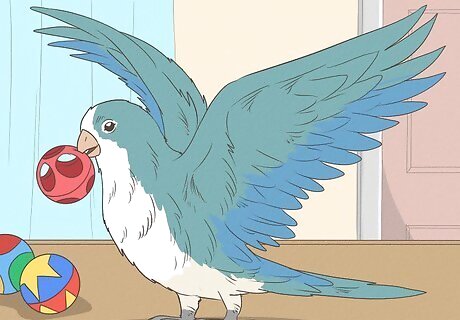
Keep the parrot actively engaged. Quakers want to be “a part of the action,” so don’t isolate them in a cage tucked away in a low-traffic spot. Like a small child, regular, active attention will make your quaker happier and healthier. Locate your birdcage in the main living space, such as a living room. Place it in a (non-remote) corner of the room, however, so that your quaker can feel actively involved yet have a piece of territory to call its own. Give the birds plenty of daily time out of the cage as well. Do this not just for playtime but during daily activities when possible as well. Make your quaker a true part of the family.
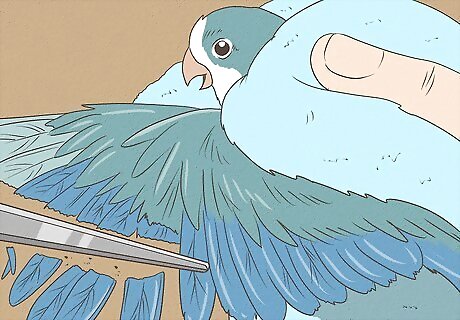
Protect your bird. Because of their mischievous and sometimes reckless nature, you need to take steps to protect your quaker from itself, not just people and other pets. The practice of wing-clipping is controversial. Clipping makes escape less likely and reduces the risk of injury by flying into objects. See How to Clip a Parrot’s Wings or visit your vet for more information. However, the bird's ability to fly is curtailed. This means he gets less exercise and is more likely to feel frustrated. In addition, many birds try to fly but crash land and damage their brisket. These injuries can be quite severe and the thinking is now that wing-clipping is outdated. Instead, adequate training (such as clicker training) is preferred, to control the bird during out of cage time. Some Quakers are fearless (or perhaps foolish) enough to go after cats or dogs, which can result in severe injuries or worse, so take care if you have other pets in the house. The only way to know how they will interact is to let it happen, but be prepared to keep Quakers separated from other pets if necessary. The same goes for other birds as well. Some Quakers thrive with an additional “partner in crime,” others not so much. Exposure at a young age is probably the best bet for success. Exposing your quaker to other people early on is also the best way to keep it from becoming a “one-person bird” who only interacts well with you. It is a two-way street, though, and you may have to instruct people (especially children) how to act around your parrot.
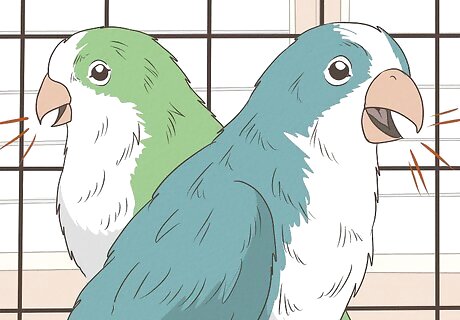
Embrace the chaos. If you prefer your home and life to be neat and tidy, quiet, regimented, and predictable, a quaker (or any parrot, for that matter) is probably not for you. If you can accept an occasional giant mess, a missing watch, and regular squawking as a fair trade for a good bit of fun and constant companionship, a quaker parrot may be just the thing for you.
Knowing Your Quaker
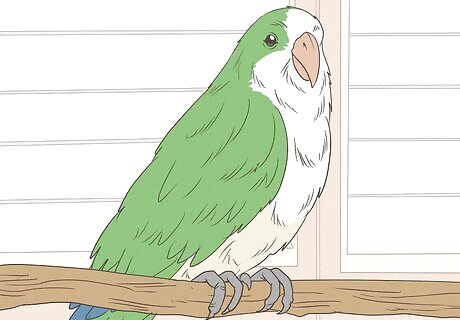
Learn about the species. Quakers are not the largest or most colorful of parrots, but they are among the smartest and (depending on the individual bird) most talkative. Familiarize yourself with the following general details before considering an acquisition: They average about 11–13 inches (28–33 cm) in length, and are typically grayish-white and green in color. They can live for 30 years in captivity, so consider this a long-term addition to your household. Quakers hail originally from temperate parts of South America but seem to thrive in just about any climate. Concern about escaped Quakers’ ability to thrive and overwhelm native ecosystems is part of why ownership of the species is banned or restricted in over a dozen states, including California. Check your home state’s current policies before moving forward with any acquisition plans.
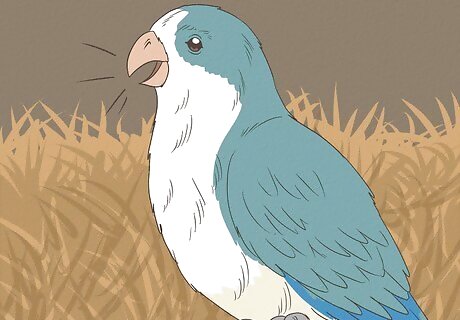
Know quaker parrot tendencies. Terms like “smart,” “fearless,” “curious,” and “mischievous” pop up frequently in descriptions of Quakers, and with good reason. Living with one is akin in many respects to living with a small child. They are typically fast learners and gifted mimics, so Quakers usually make very talkative avian companions. (Never assume that any individual parrot, regardless of species, will be a talker, however.) Despite being talkative (and “squawkative,” for lack of a better term), however, they are not usually overly loud compared to other parrot species. Quakers build nests in the wild that are akin to apartment blocks, with multi-room “apartments” built adjacent to those of other surroundings “tenants.” For this reason, they are naturally adept borrowers (or thieves, depending on your perspective). Quakers will take anything from eyeglasses to pens to paper scraps and stash them away in their cages, as part of their instinct to collect materials for their elaborate nests.
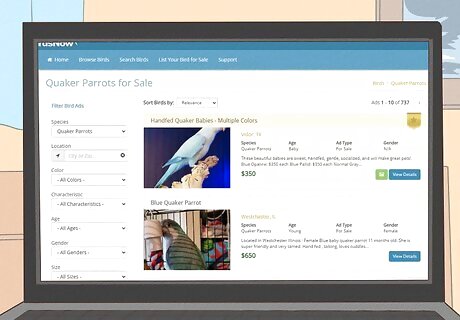
Consider where you should acquire one. Quakers often cost between $50 and $200 to purchase, making them manageable for most interested buyers. Not only the price but the personality of the bird you’re getting may be determined by where you acquire it. Common places include: A responsible breeder. This will cost more than alternatives but is your best bet for getting a loving, hand-fed baby. A parrot rescue. Quakers may not be commonly available here, but if you are lucky, you might be able to find one. You will not get a baby, but the cost will be less, and the parrot will be in a needful and loving home. A shelter. It is unlikely that you will find your quaker here, but check nonetheless. You probably will not have any idea of your Quaker's history if you adopt from here, and the shelter route is only recommended to experienced bird owners. A pet store. Do your homework before considering whether to buy from here. The prices might be cheaper, but you may be getting an unhealthy bird that is less than your money's worth. Not to mention that many pet stores buy their parrots from disreputable sources that use inhumane methods for acquiring and breeding their birds. From the newspaper, online, etc. Some people may be re-homing their Quakers, and this is a fine place to get one, but remember to check that they are not rehoming their parrot because of medical or behavioral issues.
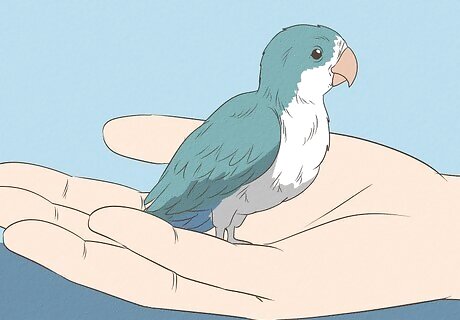
Decide whether to choose a baby or adult bird. It may be tempting to think that an adult bird that has already been trained and socialized would be easier to care for, especially for a novice, but that may not be the case. The best chance of training the bird, establishing good habits, and handling the bird is with a youngster. Quakers can develop a strong attachment to a particular individual, so an adult quaker may have trouble adjusting to a new home and "parent." Also, unless you are sure of the bird's history, you may be acquiring one with a history of behavioral issues, perhaps even because of neglect or abuse. It is a noble gesture to take in a rescue quaker, but it may present too great a challenge if you do not have previous experience. As indicated in the previous step, acquiring a baby quaker that has been hand-fed is probably the safest route (if likely most expensive), especially if you don't have much experience caring for birds. There are no guarantees, of course, but a quaker that has been cared for responsibly since birth is most likely to become a well-adjusted, loving adult. If you do choose a baby quaker, set up your home with its cage, toys, etc. prior to its arrival like you would with a baby's crib and such. Be ready to welcome it to its new home.


















Comments
0 comment